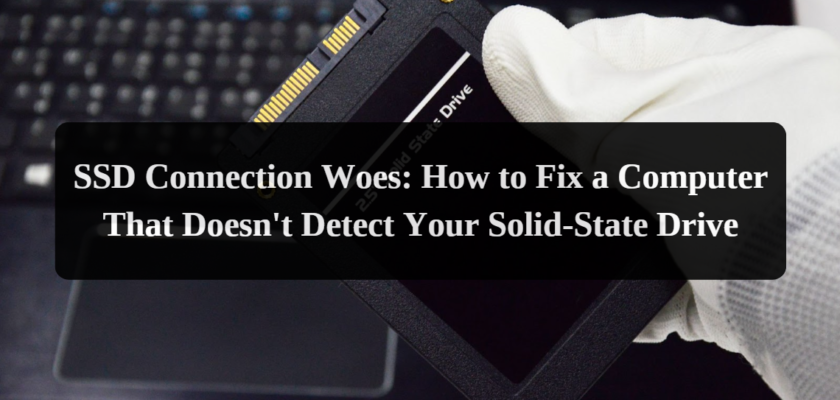Common Causes of SSD Recognition Issues
Solid State Drives (SSDs) are popular for their speed, durability, and performance enhancement. However, sometimes, you may encounter problems with your computer not recognizing the SSD. This can be due to various reasons, which we will discuss below.
Computer Not Recognizing SSD
The first and most obvious problem is that your computer does not recognize the SSD. This could be due to several factors, including faulty connections, incorrect BIOS or UEFI settings, or the drive itself being wrong.
Faulty Connections
Faulty or loose connections between the SSD and the motherboard can prevent the computer from recognizing the SSD. This includes problems with the SATA or NVMe connector, the power cable, or the data cable.
BIOS and UEFI Settings
Incorrect BIOS or UEFI settings can also lead to SSD recognition issues. For example, if the BIOS/UEFI is set to Legacy mode instead of UEFI mode or if the AHCI mode is disabled, the computer may not recognize the SSD.
How to Make Windows Recognize Your SSD
If your Windows operating system is not recognizing your SSD, here are some steps to follow to fix the issue.
How to Get PC to Recognize New SSD
If you have recently installed a new SSD and your PC does not recognize it, follow these steps:
- Check the physical connections: Ensure the SSD is properly connected to the motherboard and the power supply.
- Check the BIOS/UEFI settings: Ensure the BIOS/UEFI settings are correctly configured.
- Check-in Disk Management: Open the Disk Management tool in Windows and check if the SSD is listed there. You will need to initialize the disk if it is listed but has yet to be initialized.
Adjusting BIOS/UEFI Settings
To adjust the BIOS/UEFI settings:
- Restart your computer and enter the BIOS/UEFI setup by pressing the appropriate key (usually F2, F12, DEL, or ESC) during startup.
- Navigate to the Boot, Boot Order, or Boot Priority menu.
- Make sure the SSD is listed and set as the first boot device.
- Save the settings and restart your computer.
Device Manager and Disk Management
Check the Device Manager and Disk Management tools if Windows does not recognize the SSD.
- Open the Device Manager and check if the SSD is listed under the Disk drives section. There might be a driver issue if it is listed but has a yellow exclamation mark. Update the driver by right-clicking on the SSD and selecting Update driver.
- Open the Disk Management tool and check if the SSD is listed there. If it is listed but not initialized, right-click on the SSD and select Initialize Disk. Follow the on-screen instructions to initialize the disk.
Physical Connection Checks and Solutions
Ensuring that the SSD is properly connected is crucial for it to be recognized by the computer.
Ensuring Proper SATA or NVMe Connection
Ensure the SSD is properly connected to the motherboard and the power supply. For a SATA SSD, connect the SATA data cable to the motherboard and the SATA power cable to the power supply. For an NVMe SSD, insert it into the M.2 slot on the motherboard and secure it with a screw.
Inspecting and Replacing Cables
Inspect the cables connecting the SSD to the motherboard and the power supply. If the wires are damaged or loose, replace them with new ones.
Re-seating the SSD
If the SSD is not properly seated in the motherboard or the M.2 slot, the computer may not recognize it. Remove the SSD and reinsert it, making sure it is securely connected.
Troubleshooting BIOS/UEFI Settings
Incorrect BIOS or UEFI settings can lead to SSD recognition issues. Follow these steps to troubleshoot the BIOS/UEFI settings.
Accessing BIOS/UEFI
Restart your computer and enter the BIOS/UEFI setup by pressing the appropriate key (usually F2, F12, DEL, or ESC) during startup.
Enabling AHCI Mode
Make sure the AHCI mode is enabled in the BIOS/UEFI settings. This mode is essential for the proper functioning of the SSD.
Checking Boot Order
Ensure the SSD is listed in the boot order and set as the first boot device. If the SSD is not listed, the computer may not recognize it.
Additional Tips and ConsiderationsUpdating Firmware
Updating the firmware of the SSD can sometimes resolve recognition issues. Check the manufacturer’s website for the latest firmware update and follow their instructions to update the firmware.
Driver Updates
Make sure the drivers for the SSD and the motherboard are up-to-date. Check the manufacturer’s websites for the latest drivers and install them.
Compatibility Issues
Ensure that the SSD is compatible with your computer. Some motherboards may not support NVMe SSDs, and some may not support SATA SSDs. Check the motherboard’s specifications to ensure compatibility.
Seeking Professional Help
If you have tried all the above steps and the SSD still needs to be recognized, it is recommended to seek professional help. An experienced technician can help diagnose and fix the problem.
Conclusion
SSD recognition issues can be frustrating, but they can usually be resolved with some patience and troubleshooting. Ensure the physical connections are secure, the BIOS/UEFI settings are correct, and the drivers and firmware are up-to-date. If all else fails, seeking professional help is recommended.

